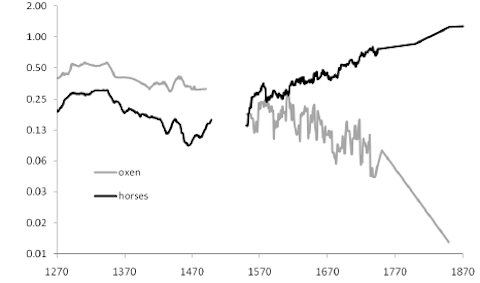
Putting the finishing touches on a long-gestating major project this a.m., so just a quickie before I get back to ironing out some word-choice matters. The graph above comes from the much buzzed-about paper estimating that per-capita GDP in late Medieval England was around $1,000 in 1990 dollars—an estimate that, if accurate, would mean that the Joe Sixpacks of 1600s England were better off than contemporary residents of Burundi and Niger. I’m skeptical of this claim, primarily because the paper itself (PDF) makes no such grandiose claims—it was the public-relations department at Warwick University that added that extrapolation in its press release.
Still, the research makes for fascinating reading, and the authors were kind enough to include a bevy of helpful graphs and charts. My favorite is the horses-versus-oxen illustration I’ve selected for your viewing pleasure. Why did the English kiss off their oxen so rapidly after 1700 or thereabouts? Some clues are to be found in this 1989 article about the rise of the horse:
Horses often represented a much smaller capital investment than oxen, a matter of key importance for peasant cultivators in particular. This was because oxen always retained their value as meat, no matter how old they were, while elderly horses, due to the well-known and widely observed taboo on eating horseflesh, had little more value than their hides. Consequently, compared to oxen, the price range for horses was exceedingly wide – from over £100 for a prized war-horse all the way down to as little as 2s. for an old nag that may have been blind or lame but was still capable of some useful work. The horse trade in fact has often been compared to that for used cars today. As Joan Thirsk put it over a decade ago, ‘…there is a car within the price of everyone; you can pay £20 or you can pay £10,000’. The same applied for horses in the medieval period, where the wide variation in prices for the animals allowed peasants to acquire cheap horses much as the ‘banger’ trade in cars allows teenagers to do the same today.
Gadget development also played a role: The invention of the padded horse collar doesn’t get nearly enough adulation in geek circles.


scottstev // Dec 8, 2010 at 11:05 am
I’m currently reading a history of early Virginia Colonial History. What struck me, is that the draconian (for that era) work requirements in Jamestown set up by John Smith adds up to about 4 hours a day. Even then, the colonists, in many cases, were too idle to keep from starving; often refusing to plant sufficient corn for the winter, fully knowing it could be a matter of life and death.
The Indian tribes, had a system of managing the forest that provided great food for almost no work per day 2 hours. The women performed all domestic work, including farming, while the men would either hunt or fight wars, which were often merely demonstrations of prowess and strength. They hadn’t realized yet that Europeans played for keeps.
Jordan // Dec 8, 2010 at 1:00 pm
Yeah, that got covered in the Cartoon History of the Universe, one of my favorite “history of everything” reviews ever.
@scotttstev
While it’s not all clear at this point, there are a lot of really interesting arguments in “1491” by Charles Mann about how Native Americans, both north and south, did a lot to modify their environments for their benefit. Really fascinating stuff.
Brendan I. Koerner // Dec 8, 2010 at 4:05 pm
@scottstev: Why were the settlers so indolent? How did they fill up their time?
scottstev // Dec 8, 2010 at 6:30 pm
@Brendan, for one thing, the Industrial Revolution has completely changed the paradigm of what is considered indolent, they were relatively driven like dogs . English Labor contracts (in order to increase employment) had a minimum of a one year term no matter how much work there was to do. Hence laborers in general had little incentive to maximize productivity. The laborers in the Colonies were not exactly top-drawer, even by those modest standards.
Also, class-structure had an influence, with “Gentlemen” being distinct as a class for doing NO work whatsoever. To condescend so low as to pick up a hoe or a rake, is quite a comedown.
Indians would provide sustenance through gifts, trade, or theft. The more contact the two groups had, the further strained their relationships became. Eventually the Virginia Colonies went broke as a going concern, although Tobacco provided wealth for many.
Not sure what they did with their time, but I’d bet long nights and a lack of artificial illumination kept activity low.
Borne Forward Ceaselessly Into MMXI | Microkhan by Brendan I. Koerner // Dec 30, 2010 at 10:24 am
[…] Cutting out a little early on 2010 to prep for 2011; today’s all about wrapping up loose ends, drawing up New Year’s resolutions, and game-planning for what’s sure to be another madcap 12-month stretch. Lots in the works, starting with my long-promised Jazz Age yarn. As always, check this space for details—or simply because you have a hankering to learn more about kabaddi, the Solomon Islands, or trends in oxen usage. […]